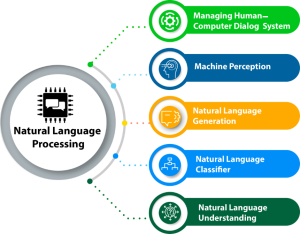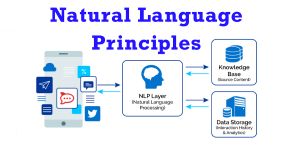Unlocking the Power of Natural Language Processing (NLP):
In an increasingly digital world, the ability to understand and process human language is a transformative force. Natural Language Processing (NLP) stands at the forefront of this revolution, enabling machines to comprehend, analyze, and generate human language. In this comprehensive guide, we will delve deep into the world of NLP, exploring its foundations, key applications, challenges, and future prospects.
Understanding Natural Language Processing (NLP)
At its core, NLP is a subfield of artificial intelligence (AI) that focuses on the interaction between computers and human language. It aims to bridge the gap between human communication and machine understanding by enabling computers to interpret, process, and generate human language in a meaningful way.
 Key Components of NLP
Key Components of NLP
- Text Analysis: NLP begins with the analysis of text data, which can include written documents, emails, social media posts, and more. Text analysis involves tasks such as tokenization (breaking text into words or phrases), part-of-speech tagging (identifying the grammatical role of words), and named entity recognition (identifying names of people, places, and organizations).
- Sentiment Analysis: Sentiment analysis, or opinion mining, determines the sentiment expressed in a piece of text, whether it’s positive, negative, or neutral. This is especially valuable for understanding customer feedback, social media trends, and public sentiment towards products or brands.
- Machine Translation: Machine translation systems like Google Translate utilize NLP techniques to automatically translate text from one language to another. This involves complex tasks like syntactic analysis and context understanding.
- Speech Recognition: NLP extends to speech recognition, where spoken language is converted into text. This technology powers voice assistants like Siri and Alexa, as well as transcription services.
- Question Answering: NLP systems can answer questions posed in natural language. This has applications in virtual assistants, chatbots, and search engines.
 Applications of NLP
Applications of NLP
- Chatbots and Virtual Assistants: NLP drives chatbots and virtual assistants like Apple’s Siri, Amazon’s Alexa, and chat support systems. These systems understand and respond to user queries, making them invaluable for customer service and support.
- Search Engines: Search engines like Google use NLP to understand user queries and provide relevant search results. This includes understanding user intent and context.
- Social Media Analysis: NLP is used to analyze social media conversations, detect trends, and gauge public sentiment. It’s instrumental for brands monitoring their online presence and reputation.
- Content Recommendation: Streaming platforms like Netflix and music services like Spotify employ NLP to recommend content to users based on their preferences and viewing/listening history.
- Language Translation: NLP powers machine translation services that make it possible to translate text and even speech from one language to another.
- Healthcare: NLP is used in healthcare for extracting insights from medical records, analyzing patient data, and assisting in diagnoses.
- Finance: In finance, NLP helps analyze news sentiment to predict market trends and assess investment risks.
Challenges in NLP
While NLP has made significant strides, it still faces several challenges:
- Ambiguity: Human language is inherently ambiguous, with words and phrases often having multiple meanings depending on context. NLP systems struggle with disambiguating meaning.
- Lack of Context: Understanding context is crucial for accurate language processing. NLP systems sometimes struggle to grasp context, leading to misinterpretations.
- Data Quality: NLP models require large amounts of high-quality training data. Biases in data can lead to biased AI systems, which is a growing concern.
- Multilingual Understanding: Achieving true multilingual understanding remains a challenge, as language structures and idioms can vary significantly.
Future Prospects of NLP
The future of NLP holds immense promise:
- Advanced Chatbots: Chatbots will become even more sophisticated, capable of nuanced conversations and understanding emotional context.
- Human-AI Collaboration: NLP will facilitate closer collaboration between humans and AI, particularly in content creation, analysis, and customer service.
- Healthcare Revolution: NLP will play a pivotal role in revolutionizing healthcare by automating tasks like medical transcription and aiding in diagnoses.
- Language Preservation: NLP can help preserve endangered languages by digitizing and analyzing linguistic data.
- Enhanced Personalization: Content recommendation and personalization will become increasingly accurate, enhancing user experiences.
- Ethical Considerations: Addressing biases in NLP systems and ensuring ethical use will be paramount.
Getting Started with NLP
For those interested in diving into NLP, here’s a roadmap:
- Learn Python: Python is the preferred language for NLP due to its extensive libraries and frameworks. Start with Python basics if you’re not already proficient.
- Understand Text Preprocessing: Learn how to clean and preprocess text data, including techniques like tokenization and stemming.
- Study NLP Libraries: Familiarize yourself with NLP libraries and frameworks like NLTK, spaCy, and TensorFlow.
- Practice Sentiment Analysis: Start with sentiment analysis projects to understand how NLP models can determine sentiment in text data.
- Build Chatbots: Create simple chatbots using NLP techniques and frameworks. Experiment with different applications.
- Explore Advanced Topics: As you gain experience, explore advanced NLP topics like neural networks, sequence-to-sequence models, and transformer models.
Conclusion
Natural Language Processing is at the heart of human-computer interaction in the digital age. Its applications span industries, from healthcare to finance, and its potential for enhancing communication and understanding is boundless. As you embark on your journey into NLP, remember that it’s a dynamic field, continuously evolving with new techniques and applications. By mastering the fundamentals and staying curious, you can contribute to the exciting developments that lie ahead in the world of NLP.

